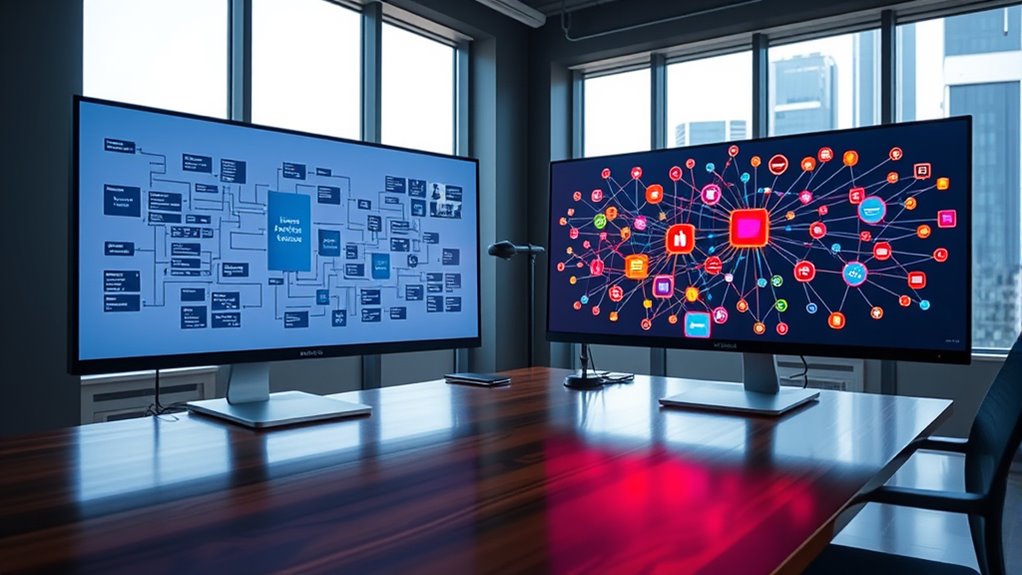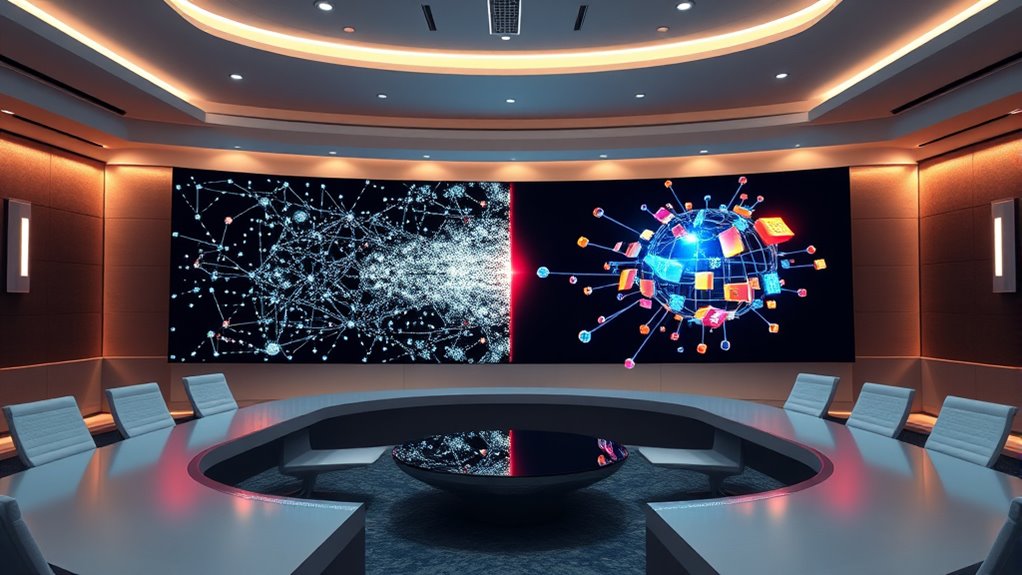By 2025, software architecture has shifted from traditional monoliths to flexible, event-driven microservices, enabled by container orchestration tools like Kubernetes. You’ll find systems become more decoupled, scalable, and resilient, with services communicating asynchronously through events. This approach supports rapid deployment, easier updates, and improved system responsiveness. If you keep exploring, you’ll discover how these trends are shaping robust, adaptable architectures designed to meet fast-changing technological demands.
Key Takeaways
- Event-driven architectures in 2025 favor microservices for scalability, responsiveness, and decoupled system components.
- Monoliths are increasingly replaced by modular microservices supporting rapid development and deployment.
- Container orchestration tools like Kubernetes streamline microservice management, scaling, and resilience.
- Microservices enable independent service updates, reducing downtime and enhancing system flexibility.
- Monolithic architectures struggle with agility and scalability compared to modern, event-driven microservice designs.

Have you ever wondered what software architecture will look like in 2025? As technology evolves, so do the ways you design and build systems. One significant shift is the increasing adoption of event-driven design, which enables your applications to respond more dynamically to real-time data. Instead of relying solely on traditional request-response models, you’ll find that systems are becoming more decoupled and reactive. This approach allows different components to communicate through events, making your applications more scalable and resilient. For example, when a user uploads a photo, the event triggers multiple services—thumbnails generation, image analysis, notification dispatch—each operating asynchronously. This kind of architecture reduces bottlenecks and improves overall performance, especially when combined with container orchestration tools like Kubernetes or Docker Swarm. These platforms allow you to manage, deploy, and scale your microservices effortlessly, ensuring your system adapts smoothly to fluctuating demands. Container orchestration simplifies complex deployments, automates failover, and optimizes resource utilization, which is essential as your architectures grow more intricate. As a result, your system becomes more resilient and easier to maintain, even as you add new features or scale existing ones. These advancements mean that monolithic architectures, which once dominated the landscape, will increasingly give way to more flexible, modular setups. Microservices—supported by event-driven design and container orchestration—enable you to develop, test, and deploy features independently, reducing time-to-market and increasing agility. You’ll no longer be locked into monolithic codebases that are hard to update or scale; instead, you’ll craft a collection of small, autonomous services that work together seamlessly. This shift also encourages a DevOps culture, where continuous integration and continuous delivery (CI/CD) pipelines become standard practice, further accelerating your development cycles. Additionally, the combination of event-driven design with container orchestration allows your system to handle failures gracefully. When one service goes down, others can continue functioning, keeping your overall system available and responsive. This resilience is indispensable as systems become more complex and distributed across multiple data centers or cloud environments. By 2025, you’ll see these concepts integrated deeply into your architecture choices, making your systems more adaptable, scalable, and easier to manage. Incorporating high-quality dietary fiber, like that found in chia seeds, can also promote gut health and improve digestion, which is essential for overall well-being. Whether you’re building a new platform or modernizing an existing one, embracing event-driven design and container orchestration will be key. They’ll empower you to create systems that are not only powerful but also flexible enough to meet the rapid pace of technological change, ensuring your software remains robust, efficient, and future-proof.
Frequently Asked Questions
How Will AI Influence Future Software Architecture Decisions?
AI will profoundly influence your future software architecture decisions by enabling AI-driven design, which optimizes structures for performance and scalability. You’ll increasingly adopt autonomous systems that can self-manage and adapt, reducing manual oversight. This shift encourages more flexible, resilient architectures, whether microservices or monoliths. Embracing AI’s capabilities helps you create smarter, more efficient systems that evolve dynamically, ensuring your architecture remains competitive in a rapidly advancing technological landscape.
What Are the Environmental Impacts of Different Architecture Styles?
Think of architecture styles like different eco-friendly designs—you’ll find microservices often have a smaller environmental footprint, thanks to resource optimization, while monoliths might consume more energy due to their larger scale. Microservices enable efficient resource use and easier updates, reducing waste. Choosing the right style allows you to minimize environmental impact, supporting sustainability goals. Your architecture decision can directly influence energy consumption and overall ecological footprint.
How Does Global Connectivity Affect Architecture Scalability?
Global connectivity profoundly impacts architecture scalability by enabling distributed networks that grow seamlessly across regions. You can leverage this connectivity to expand your system’s reach without huge overhauls, but you must also consider data sovereignty laws. This means designing your architecture to handle distributed data storage and processing, ensuring compliance while maintaining performance. Ultimately, global connectivity allows for scalable, flexible systems, but you need to balance openness with legal and regulatory constraints.
What Role Will Edge Computing Play in Software Architecture Evolution?
Edge computing will revolutionize your software architecture by turning every device into a mini data center. With edge intelligence and data decentralization, you’ll enjoy faster processing and reduced latency—who needs centralized servers anyway? Expect a smarter, more responsive system where decisions happen locally, not in some distant cloud. It’s like giving your infrastructure a brain boost, making your architectures more agile, resilient, and, frankly, a lot more fun to manage.
How Can Architecture Adapt to Rapid Technological Change?
You can adapt to rapid technological change by embracing modular design, which allows you to update or replace components without overhauling the entire system. Incorporate flexible architectures that support legacy integration, ensuring your existing systems evolve smoothly alongside new innovations. Stay agile, continuously monitor emerging trends, and be ready to refactor or re-architect as needed, so your infrastructure remains resilient and competitive in a fast-changing tech landscape.
Conclusion
As you weigh the benefits of microservices against monoliths, remember that neither is inherently better—each has its place. While microservices offer agility and scalability, they can also introduce complexity. Monoliths, on the other hand, provide simplicity but may struggle to adapt. Ultimately, your choice depends on your project’s needs, much like choosing between a swift race car and a reliable sedan. In the end, it’s about aligning architecture with your goals.









